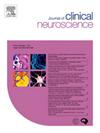Outcomes of awake surgery for recurrent glioblastoma: A single-institution retrospective analysis
IF 1.9
4区 医学
Q3 CLINICAL NEUROLOGY
引用次数: 0
Abstract
Background
Awake surgery facilitates maximal safe resection of brain tissue in cases of glioma, but its effectiveness for recurrent glioblastoma (GBM) remains unestablished. In this study, we investigate the safety, success rate of mapping, and surgical outcomes of awake surgery for recurrent GBM.
Methods
This study included glioma cases that underwent awake surgery at our hospital between March 2010 and February 2023 and met the following criteria: (1) cases with a pathologic diagnosis of glioblastoma or astrocytoma, isocitrate dehydrogenase-mutant, WHO grade 4 at recurrence, and (2) cases in which this was the second surgery in the course of treatment. We retrospectively analyzed the clinical features, mapping response, resection rate, postoperative complications, overall survival (OS), and progression-free survival (PFS).
Results
Forty-one cases were analyzed. The median age was 47 years, and 24 patients (58.5 %) were male. Awake mapping was successfully completed in 35 cases (85.4 %). A positive response to mapping was observed in 20 cases (48.8 %), which limited resection in 15 cases (36.6 %). The extent of resection was gross total resection in 20 cases (48.8 %), subtotal resection in 11 cases (26.8 %), partial resection in 8 cases (19.5 %), and biopsy in 2 cases (4.9 %). Acute-phase neurological deficits developed in 10 cases (24.4 %), but sequelae or symptom exacerbations were observed in 2 cases (4.9 %). The median post-recurrence OS and PFS were 18.7 months and 7.2 months, respectively.
Conclusions
Awake mapping for recurrent GBM demonstrated a low complication rate and facilitated tumor resection without exacerbating neurological symptoms. Awake surgery for recurrent GBM may contribute to prolonged survival.
求助全文
约1分钟内获得全文
求助全文
来源期刊

Journal of Clinical Neuroscience
医学-临床神经学
CiteScore
4.50
自引率
0.00%
发文量
402
审稿时长
40 days
期刊介绍:
This International journal, Journal of Clinical Neuroscience, publishes articles on clinical neurosurgery and neurology and the related neurosciences such as neuro-pathology, neuro-radiology, neuro-ophthalmology and neuro-physiology.
The journal has a broad International perspective, and emphasises the advances occurring in Asia, the Pacific Rim region, Europe and North America. The Journal acts as a focus for publication of major clinical and laboratory research, as well as publishing solicited manuscripts on specific subjects from experts, case reports and other information of interest to clinicians working in the clinical neurosciences.
 求助内容:
求助内容: 应助结果提醒方式:
应助结果提醒方式:


